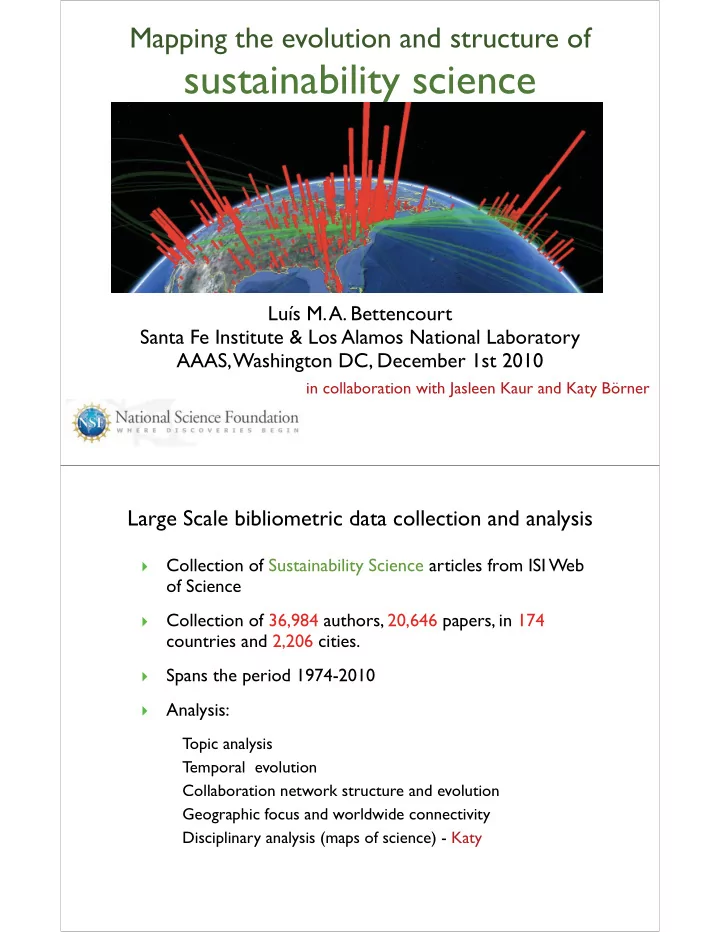

Mapping the evolution and structure of sustainability science Luís M. A. Bettencourt Santa Fe Institute & Los Alamos National Laboratory AAAS, Washington DC, December 1st 2010 in collaboration with Jasleen Kaur and Katy Börner Large Scale bibliometric data collection and analysis Collection of Sustainability Science articles from ISI Web ‣ of Science Collection of 36,984 authors, 20,646 papers, in 174 ‣ countries and 2,206 cities. Spans the period 1974-2010 ‣ Analysis: ‣ Topic analysis Temporal evolution Collaboration network structure and evolution Geographic focus and worldwide connectivity Disciplinary analysis (maps of science) - Katy
first impressions titles & keywords word frequency from publication titles
ISI keywords temporal evolution from policy to scientific field
Ideas as ‘epidemics of knowledge’ Population models of scientific fields Bettencourt, Kaiser, Kaur 2008, 2009 exposed infectious recovered susceptibles competing ideas describe the dynamics of growth of the field
population model idea contagion and field growth exponential growth authors ~ exp t/t 0 t 0 =12 years Bettencourt, Kaiser, Kaur 2008, 2009 critical periods and growth increased contact rate 1989-2000 PNAS sustainability science NAS Our common journey field unifies our common future Agenda 21 UN brundtland report Rio “Earth Summit” World Conservation Strategy
collaboration network evolution evolution of the field’s social structure The network structure of scientific revolutions Kuhn 1961 “paradigm shift” “normal science” crisis time discovery invention “exceptional science” giant component emerges transition to a graph fragmentation larger & denser graph
densification of network number of collaborations increase superlinearly with authors edges = e 0 (authors) b b=1.23 [1.20,1.25] For every fractional increase in numbers of authors, collaboration increases by 23% per capita network densifies percolation as field formation a giant component of collaboration signals field formation field formation ~2000 collaboration cluster variance fractional size of largest cluster Bettencourt, Kaiser, Kaur, 2009 topological transitions and field formation
regional distribution nations, cities and international networks National Rankings in Sustainability Science developing nations show quality rank nation papers rank nation citations rank nation cit/paper 1. us 9435 1. us 87741 1. dutch antilles 44.0 2. england 2993 2. england 19327 2. gambia 29.2 3. australia 2503 3. australia 14949 3. zaire 21.0 4. canada 2084 4. canada 13911 4. nepal 18.4 4. germany 1370 5. netherlands 7601 5. iceland 14.4 6. netherlands 1193 6. germany 6634 6. mauritius 14.3 7. france 1038 7. france 6190 7. congo 13.8 8. peoples r china 988 8. sweden 5299 8. philippines 13.3 9. brazil 832 9. peoples r china 3949 9. honduras 11.7 10. spain 825 10. italy 3833 10. chile 11.3 11. italy 762 11. switzerland 3446 11. kenya 10.2 12. india 699 12. new zealand 3263 12. martinique 10.0 13. sweden 644 13. india 3038 13. uganda 9.7 14. japan 575 14. scotland 2771 14. cote d’ivoire 9.7 15. switzerland 563 15. spain 2629 15. us 9.3 16. scotland 490 16. brazil 2596 16. ecuador 9.2 17. south africa 475 17. south africa 2585 17. zambia 8.6 18. new zealand 474 18, japan 2171 18. bolivia 8.6 19. belgium 319 19. kenya 2110 19. solomon islands 8.5 20. turkey 302 20. austria 2096 20. seychelles 8.5
world city rankings rank city papers rank city citations 1. washington dc 672 1. washington dc 3943 2. london england 3938 2. london england 612 3. melbourne australia 395 3. boston ma 2644 4. nijmegen netherlands 390 4. stockholm sweden 2599 5. wageningen netherlands 2561 5. boston ma 364 6. paris france 345 6. seattle wa 2449 7. vancouver bc canada 322 7. madison wi 2098 8. brisbane australia 321 8. san francisco ca 2014 9. beijing peoples r china 317 9. ft collins co 2006 10. new york ny 290 10. stanford ca 1990 11. sidney australia 284 11. new york ny 1982 12. camberra australia 275 12. corvallis or 1882 13. nairobi kenya 1726 13. toronto on canada 257 14. zurich switzerland 249 14. gainesville fl 1644 15. perth australia 234 15. minneapolis-st paul mn 1592 16. ithaca ny 1315 16. seattle wa 229 17. rotterdam netherlands 206 17. oxford england 1248 18. chapel hill-durham-raleigh nc 206 18. davis ca 1243 19. columbus,oh 1189 19. vienna austria 205 20. stockholm sweden 190 20. beijing peoples r china 1151 21. lancaster england 184 21. bloomington in 1146 22. montpellier france 183 22. atlanta ga 1059 city distribution western hemisphere
city distribution eastern hemisphere place networks how collaborations span the globe
place networks how collaborations span the globe summary Sustainability Science is a field of science, engineering and ‣ policy growing explosively worldwide (doubling ~ 8-9 years) it is now (since 2000) formed as a field in that most authors ‣ are connected via collaboration it has a wide geographical distribution with a strong presence ‣ in both developed and developing nations capitals play major roles; the field is developed in western ‣ europe (UK, Netherlands, Scandinavia, Switzerland), and Australia. Developing nations produce quality publications. the connectivity of several developing nations (India, Brazil, ‣ China) remains incipient, and is primarily mediated by its largest research centers (New Delhi, São Paulo, Beijing) Also: Worldwide patent database in energy technologies Urban scale and carbon footprint of US metropolitan areas
Recommend
More recommend